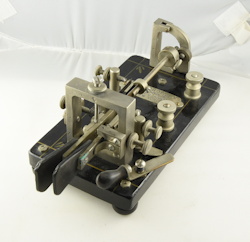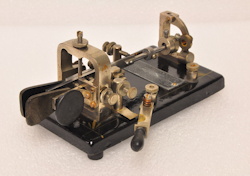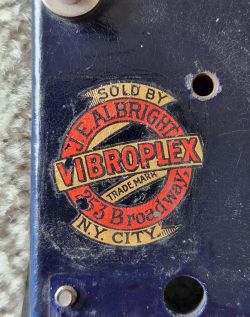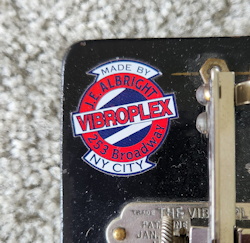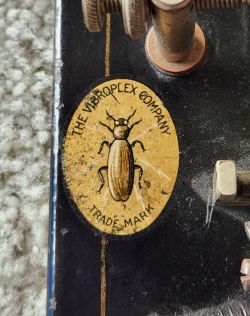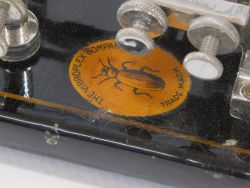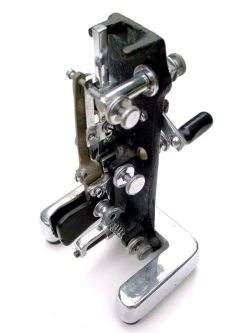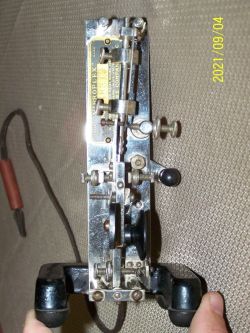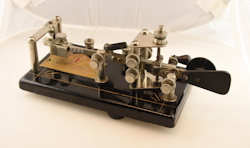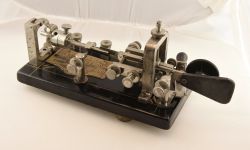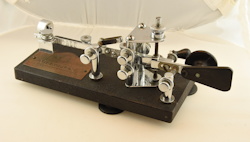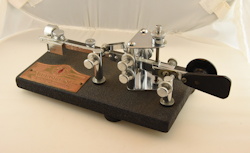Vibroplex Bugs
In 1903, Horace Martin patented a unique telegraph key called The Autoplex that operated side-to-side rather than up-and-down and used an electromagnet and interrupter circuit to produce a continuous series of "dots" when the lever was moved to the right. The purpose of this invention was to eliminate the problem of telegraphers' paralysis, also known as "glass arm" or Carpal Tunnel Syndrome, which affected telegraphers who engaged in the constant up and down motion with their telegraph key over the course of many hours each day.
The Autoplex deisgn only lasted a couple years, as Horace Martin discovered there was never a need to send a non-stop series of "dots". So he improved the design by eliminating the electromagnet/interrupter circuit and replacing it with a purely mechanical design that would send a string of up to around 8 dots at a time. This new key was called The Vibroplex. Needless to say, its popularity soared !
After the Autoplex and Original models, Vibroplex came up with numerous other models through the years, representing various levels of "improvement".Below you will find a list of all the different models, along with pictures of each.
The Vibroplex Company is still in business today ! They started out in New York City and moved between different locations in the city in the early years, and even briefly moved to Norcross Georgia (a suburb of Atlanta) for a few years before moving back to New York. Eventually they settled on an address at 833 Broadway, NY, and occupied that building from 1941 until 1979 when the company was sold and moved to Portland Maine. The company was sold again in 1995 and moved to Mobile, Alabama. Finally, the company was sold once more in 2009 and moved to Knoxville, Tennessee where it resides today.
For more information about the different Vibroplex models, including how to estimate the date your key was made from the serial number, check out Randy Cole's excellent website on Vibroplex keys.
Also, N0UF has a web page showing pictures of all the different styles of Vibroplex Nameplates.
(Click on the pictures below to see larger versions of the photo)
The Martin Autoplex (1903-1905)
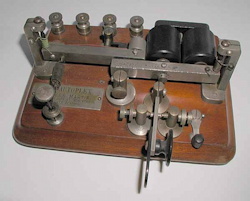 |
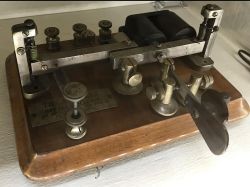 |
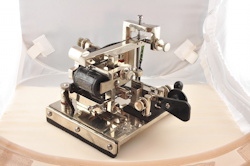 |
The Autoplex, as it was manufactured, looks quite different from the original patent drawing, but this is often the case with inventions.
It's a bit of an intimidating instrument, both in appearance and in operation. It makes quite a racket when sending dots and generates visible sparks at the keying contacts.
The first version of the Autoplex, which is quite rare, was built on a wooden base. The later version was all metal, nickel plated brass.
Vibroplex Original (1904-Present)
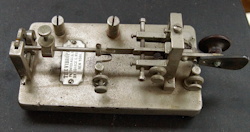 |
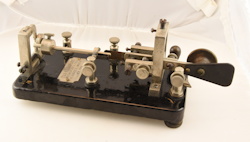 |
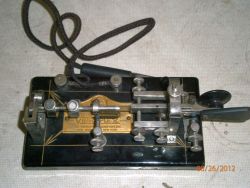 |
|---|
The first Original Model came in 2 different finishes. The standard finish was a black lacquer with gold pinstripes and "florets" along the edge. This type of finish is known a Japanned finish, as it imitates the finish on early Asian furniture.
The key was also available in nickel plated finish. The Original entered production around 1904 and is still being made today with only minor design changes,most notably the removal of the circuit closer since landline telegraph circuits are no longer in use.
Pictured above is an early nickel-plated Original, serial number 53 (left), an early Japanned base Original, serial number 252 (center), and a 1920's era Japanned base Original (right)
Thin Based Original (1907-1908)
 |
 |
 |
In 1907 Vibroplex started making their Original model bug on a thinner metal base. Because the key was now much lighter, a fold-out extension leg was used to stabilize the key on the table to prevent it from "walking". 1907 was also the year that Vibroplex moved their operation from New York to Norcross Georgia (1907-1909). So, the early Original keys made in Norcross also had the thin base. While in Norcross, Horace Martin invented the Double Lever Vibroplex. So, the first Double Lever keys also had the thin base, and are quite rare. (See below for more on the Norcross bugs)
Double Lever (1907-1926)
The Double Lever, as the name suggests, added a second short lever to be used for sending dashes.
This model was first introduced when Martin moved the Vibroplex operation to Norcross Georgia for a few years starting in 1907.
Pictured are the early model with the square frame (ca. 1907) and the later model with the cloverleaf shaped frame (ca. 1920).
Norcross, Georgia Label Keys (1907-1909)
 |
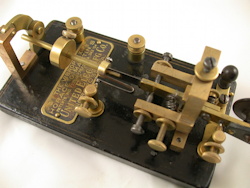 |
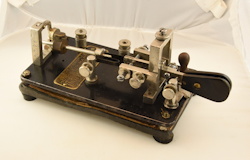 |
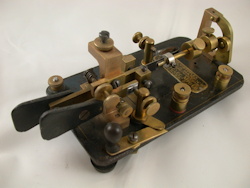 |
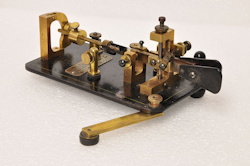 |
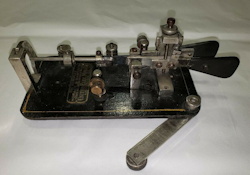 |
Martin moved the operation from New York to Norcross Georgia (between Peachtree and Thrasher Streets) for a short time starting in 1907 and sold his Vibroplex keys under the name of United Electric Mfg. Co. It was while in Norcross that he invented the Double-Lever Vibroplex. The earlier Norcross keys were built using a metal base that was much thinner than the orginal design which required the use of a fold-out extension leg to keep the key from moving around on the table. Also, most of the Norcross bugs used unplated brass parts, other than the base and mounting screws.
Because so few of the Norcross bugs were made, they are highly sought after by collectors. Pictured above (top row) is a Norcross Original on a standard thick base on the left, and a thin base Original on the right. This particular thin base key was re-mounted on a heavy solid lead sub-base, presumably because the owner lost the extension leg.
On the bottom row is a rare half-frame thin base Double Lever key (left and middle), and an unusual nickel plated half-frame Double Lever on the right.
Atlanta, Georgia Label Keys (~1909)
 |
 |
 |
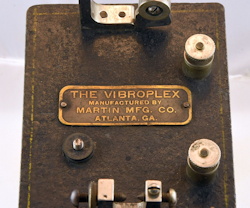 |
Norcross Georgia is a suburb of Atlanta. In 1909 Martin changed the labels on his Norcross bugs to "Atlanta Georgia" before moving the operation back to New York. Vibroplex keys with Atlanta nameplates are quite rare. So far only 4 keys with Atlanta nameplates have been found.
Model X (1911-1923)
 |
 |
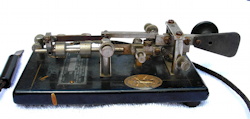 |
 |
|---|
The Model X was an interesting design modification that used an ingenious mechanism to allow both the dots and dashes to use the same set of contacts. Some people feel they are a little clunky to operate but they did the job.
There were 2 versions of this key. The first one had a square weight and pendulum arm (2 keys on the left), while the second version, called The Improved Model X, which was somewhat more simplified, used round weights and pendulum arm (2 keys on the right).
The Pseudo-X (Original / Model X Hybrid) (~1920)
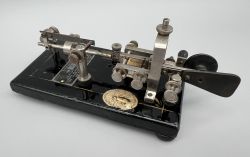 |
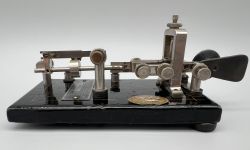 |
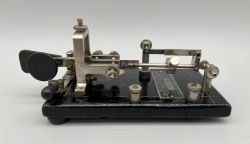 |
The Pseudo-X model was basically an Original with the Model X dot contact spring. Because the spring is located above the pendulum, the dot contact post is much taller than the post on an Original. These were only made for a short time around 1920.
Patent 457 Bug (~1912)
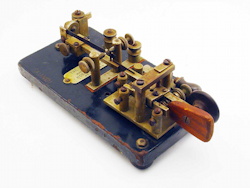 |
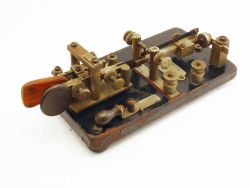 |
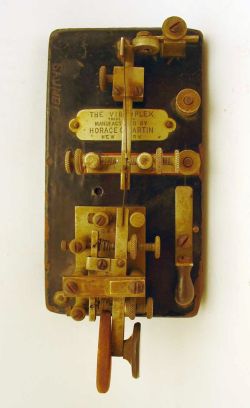 |
Although at first glance it might look like a Model X, this is actually a unique key. Horace Martin patented this key under patent number 1,042,457. If you look closely and compare the two models you can spot the differences, most notably the Patent 457 key uses 2 sets of contacts like the Original.
Supposedly 100 of these keys were made but only 1 example is currently known, making it the rarest Vibroplex model ! (Randy Cole, KN6W Collection)
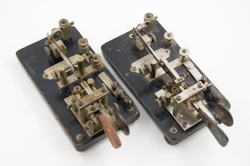 |
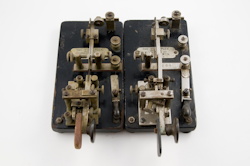 |
Above is a comparison showing the Patent 457 Bug next to a Model X. Note the Patent 457 Bug has 2 sets of contacts while the Model X only has one.
Model 4 / Blue Racer (1914-1962)
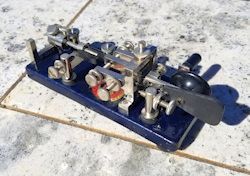 |
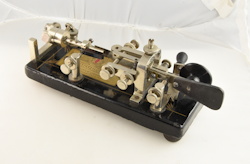 |
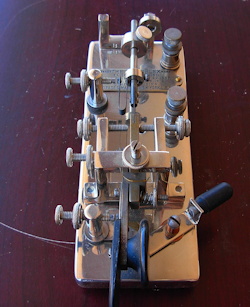 |
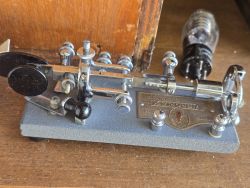 |
|---|
The Model 4, also known as the Blue Racer, was introduced in 1914. Its design and construction is pretty much identical to the Original, except for using smaller components on a narrower 2.5" wide base. (The Original model and many of the other models were built on a 3.5" wide base).
It was called the Blue Racer because one of the available finishes was a cobalt blue lacquer color. The key was also offered in black japanned lacquer with gold pinstripes, nickel plated, and later black or gray crackle paint finishes. During WW2 the key was also offered in Battleship Gray crackle finish.
Wide Base Model 4 (1920's)
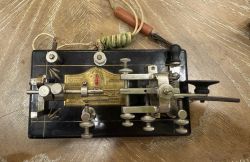 |
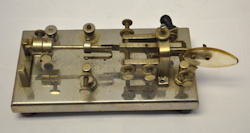 |
The Model 4 was also available on a standard size 3.5" wide base
Hess Blue Racer (1987)
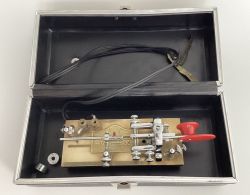 |
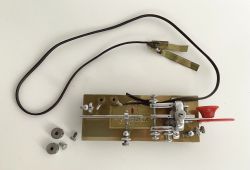 |
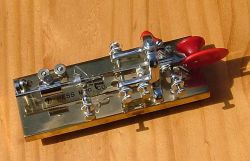 |
The Hess Blue Racer was made by W.C. Hess (Hess Manufacturing Co.) in Pasadena, California in 1987. The key featured a 1/2" thick brass base and an I-type damper. Some keys had a Vibroplex nameplate and other had a small nameplate stamped "HESS MFG. CO."
Blue Racer with Model-X Style Frame (Late 1910's to Early 1920's)
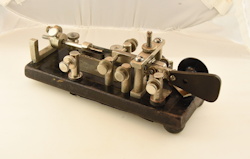 |
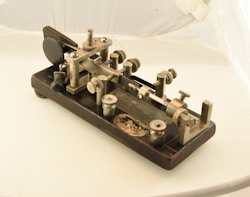 |
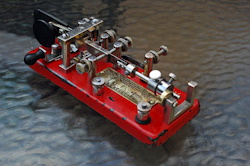 |
For a short time in the late 1910's to around 1920, Vibroplex made the Blue Racer with a Model-X style assembled frame. Only around 5 of these keys are known.
Vibroplex Decals (1913-1921)
During the 1910s, Vibroplex applied a water soluble decal to some of their keys. The first was a JE Albright decal, which was used from approximately 1913-1915, and the second was a Vibroplex Bug decal, which was used from approximately 1918-1921. Examples can be seen above.
The Upright Model (1917-1919)
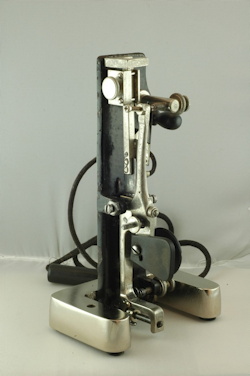 |
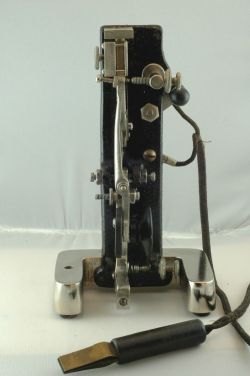 |
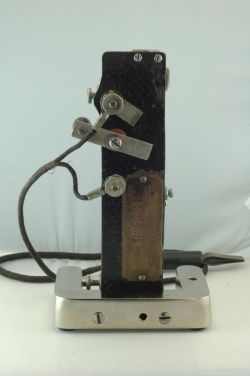 |
The Upright model was also known as The Wirechief's Key. The Wirechief usually had managerial duties to perform as well as acting as a telegrapher, so his desk often had lots of paperwork on it. The Wirechief Key took up less room on the desk. It is estimated there were around 50 of these made, and around 30 are known to exist.
The Midget (1918-1920)
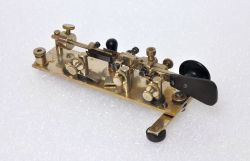 |
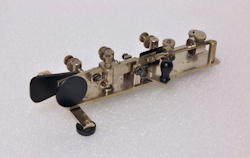 |
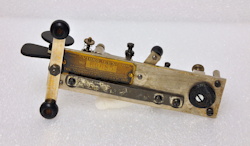 |
Another of the rarer Vibroplex Models, there are only 12 of these currently known. Due to its small size and light weight, the key required the use of a fold out extension leg to help keep it stable on the operating table. Even with the leg, the key still moved around a lot which is why it was not made for very long.
Model 6 - Lightning Bug (1927-1979)
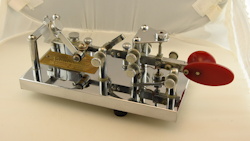 |
The Lightning Bug can be recognized by the assembled trianglular plate frame and "goalpost" damper assembly. It was a pretty popular model, judging from the fact that it was made all the way to 1979. During WW2 Vibroplex also made the Lightning Bug for the Army Signal Corps under the designator J-36.
In addition, the Lionel Corporation (yes, the model train company) also made J-36 keys of the same design for the Army. (see below)
On the left is an early Japanned base Lightning Bug, and on the right is a late chrome plated model with the Hills Vari-Speed attachment, which is used to allow the key to send slower dots. The Vari-Speed was invented by Joe Hills, W8FYO, of Dayton Ohio, who was famous for his W8FYO paddle.
Vibroplex J-36 (WW2 Era)
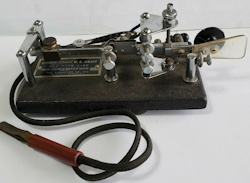 |
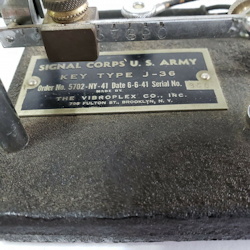 |
During WW2, Vibroplex helped support the war effort by making bugs for the US Army Signal Corps. They were given the Signal Corps designation J-36 and bore a different nameplate than their other keys. J-36 keys were also made by Lionel Corporation, JH Bunnell, and Brooklyn Metal Stamping Co. (See page on Other US Bugs)
Japanned Base Vibroplexes
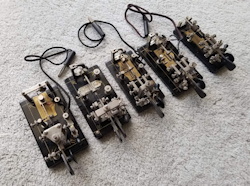 |
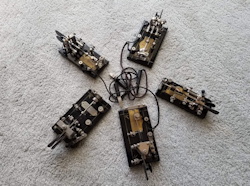 |
Many of the earlier Vibroplex models were offered with a "Japanned" finish where the base was covered with a thick layer of black lacquer then ornamental gold pinstripes and florets were added. The "Japanned" finish name came from the style that was often used to imitate the lacquer finish on old Japanese furniture. The Vibroplex Original, Double Lever, Model X, Blue Racer, Martin Junior, and Lightning bug all had a Japanned finish option. Japanned keys are quite common but finding one where the finish is in good condition and the pinstripes completely intact is another story. Above are pictures of all 6 of these models with near perfect Japanned finishes.
Colored Vibroplexes
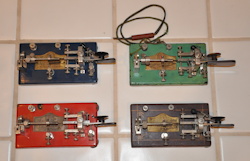 |
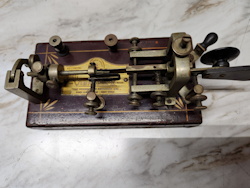 |
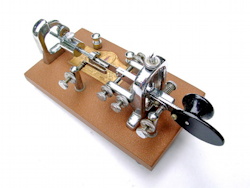 |
During the Depression era of the early 1930's, Vibroplex offered their keys (Original, Lightning Bug, Blue Racer) in red, blue, and green finish. Here is a picture of some Vibroplex Originals in all 3 colors, plus the Western Union maroon color that was available in the early 1920's. At the right is a Sienna Brown Vibroplex Original, Ca. 1979 (Randy Cole, KN6W Collection).
In the middle is a close-up of the Western Union maroon bug from the 1920's. If you look carefully you can see that "Western Union Tel Co" has been lightly stamped into the base.
In the late 1930's, Vibroplex stopped making keys with the Japanned finish and started using crackle paint finish. Also, nickel plating was replaced by chrome plating. The crackle paint finish was available in black, gray, battleship gray (during WW2) and Sienna Brown (starting around 1979).
The Martin Junior (1920-1939)
The Junior model was virtually identical to the Original model except that the base was 1/2" narrower. Another way to distinguish a Junior from an Original is the nameplate is mounted upside down compared to the Original.
Zephyr (1939-1958)
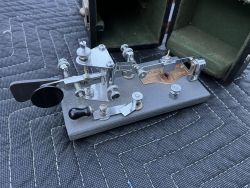 |
The Zephyr Model closely resembles the Lightning Bug with the assembled triangular plate frame. The differences are the Zephyr has a narrower 3" wide base and uses a simpler damper assembly.
Champion (1939-1980)
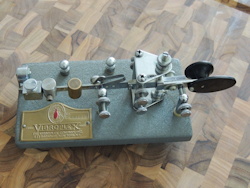 |
The Champion model is identical to the Zephyr except that it lacks a circuit closer, and has the normal 3.5" wide base.
The Rotoplex (Early 1940's)
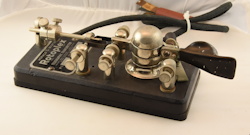 |
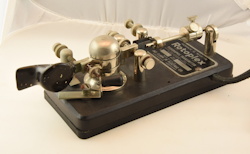 |
 |
 |
The Rotoplex was patented by Horace Martin in January 1941. However, the key was actually manufactured by James Clark Electric Co. in Louisville, Kentucky. Pictured above is the standard Rotoplex at the left, and on the right are 2 rare early versions, one with black finish and the other with nickel plated base.
Signal Corps Rotoplex (Early 1940's)
 |
 |
 |
A small number of Rotoplex bugs were made for the US Army Signal Corps and have an additional nameplate indicating as such.
Presentation Model (1948-Present)
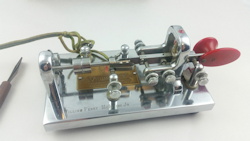 |
 |
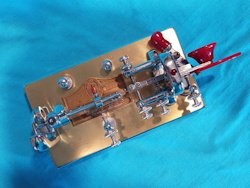 |
|---|
Around 1940, Vibroplex started using chrome plating on some of their keys. They then called the chrome plated keys "Deluxe" models, and were available with the Original, Lightning Bug, and Blue Racer.
The Presentation Model was also known as the Super-Deluxe. It was basically the same as a Deluxe model with the addition of a gold plated brass plate on top of the base. The earlier version of the key also had a mainspring that could be adjusted in length to allow the operator to change the dot speed. Also, the top of the lever pivot used a ruby colored "jewel" as a pivot rather than an adjustable screw and nut. Here are pictures of the Deluxe and Super-Deluxe, or Presentation.
Vibroplex Combo Models (Still in Production?)
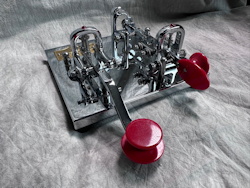 |
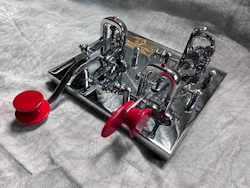 |
The Vibroplex Double Combo Model featured a Vibroplex Deluxe Original bug and a straight key on the same base.
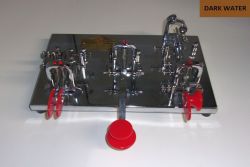 |
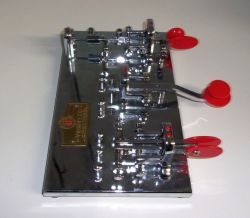 |
The Vibroplex Triple Combo Model is a large key featuring a bug, an iambic paddle, and a straight key on a single base. All chrome finish.
The Vibroplex 225 SL 2 Meter FM Transceiver
 |
 |
 |
In 1979, while Vibroplex was in Portland Maine, they introduced a 2 meter VHF FM transceiver for amateur radio use, called the Vibroplex 225 SL. It probably did not sell very well, as only one example is known !

